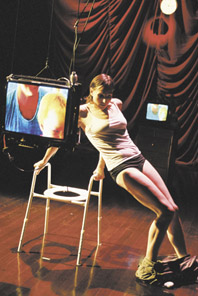The dance of living and dying
Keith Gallasch witnesses communication/failure

Victoria Spence, communicaiton/failure
Heidrun Löhr
Victoria Spence, communicaiton/failure
Between the atomic and the cosmic lies the molecular world, a turbulent, porous sphere, fluid and osmotic. According to scientists, this dance of particles has been much neglected in the wake of a 20th century preoccupation with the inner workings of the atom and the Big Bang narrative. Studies of Brownian Motion (after Brown, a 19th century botanist who observed the independent movement of pollen) suggest the potential for new material hybrids formed from the interplay of molecular structures. Having just heard this I found myself serendipitously alert to the motion, thematic and actual, in Victoria Spence’s engaging and disturbing solo performance, communication/failure.
The world Spence evokes is both atomic (the everyday in words and video images) and cosmic (metaphysical encounters with birth and death). In between, a slow, cumulative swirl of motifs gradually and hauntingly take shape as Spence attempts to grasp a moment, a point of transition in her life when substance (rooms, bodies, images) dissolves, rearranges, merges. She will convey this to us but will, at the same time, necessarily fail to do so—such is the difficulty of the task.
Spence’s persona is a still presence, addressing us directly, deliberately stringing words together in a slow staccato, initially suggesting someone remembering how to speak or a determination to utter the unspeakable. The half smile that frames the words is only half welcoming, masking, we begin to suspect, a deep anxiety. Spence tells us that the room we see now was not like that afterwards (after ‘what’, we wonder) and that she’s not sure what was beginning and what was ending. In the words, movements and images that ensue in a dream-like space enveloped in deep red velvet curtains and scattered with video monitors and microphones, the material and emotional worlds of birth (Spence’s daughter) and death (of her mother) move inexorably into one that is new and unstable, suggestive of transformation and the eternal reworking of matter, along with, perhaps, something more metaphysical.
This reverie is framed with a journey, an everyday suburban train trip viewed subjectively through a carriage window but suggestive (in the way it is eerily shot and later transformed from small images to a massive one) of constant motion, an inevitable mobility from which there is little reprieve. Video artist Sam James keeps the images relentlessy moving and Jason Sweeney’s sound conjures real world rattlings and creakings that become cumulatively and magnificently orchestral as worlds of motion merge.
Initially Spence simply sets things in motion with a welcome, with slowly acclerating sentences and the swinging of suspended monitors and microphones. Images roll by of Christmas gatherings, birthing, swimming and gawky adolescence, and the fullness of pregnancy. Later Spence’s body takes over in a kind of dance, a stiff signalling to the self, or someone somewhere, that grows furious, a helpless swimming. Soon, her body, all heightened perception, will find the dead mother’s room too full to enter, but also too empty. She takes a camera with her, but it is still too much. The countdown to the end of a life climaxes in the tearing down of the red curtain and the draping of the monitors in gauze, creating a stark world inhabited by ghosts.
Except for the moments of palpable panic, Spence conveys contained bewilderment, quiet suffering and measured awe. She neither acts out the past nor supplies us with intricate biographical material; any depths are only glimpsed, only deduced from the surfaces to which we become increasingly attentive, making what we can of the images of Spence and her family like the strangers we surely are. But what we do witness above all is a state of being in motion beneath 2 clock faces that hover over the space suggesting parallel universes where death and birth are one, where there will inevitably be ghosts (those who do not rest), and where the countdown to death will sooner or later yield its opposite with a haunting synchronicity.
It’s been a long time between shows for Spence. The wonderful voice is not quite on top of the demanding material, the movement doesn’t quite exploit the opportunities conjured, but communication/failure is nonetheless memorable, beautiful and disorienting, sparely and lucidly scripted, finely constructed and graced with a rare seriousness. Always a commanding presence, Victoria Spence sets herself a demanding task, mostly met and, like the life that seems to dance from dead grandmother to new child, the work is worthy of another incarnation.
communication/failure, writer-performer Victoria Spence, dramaturg Mark Seton, video artist Sam James, sound design Jason Sweeney, design Jade Kemety, lighting Clytie Smith; Performance Space, Sydney, Nov 9-20
RealTime issue #71 Feb-March 2006 pg. 32






